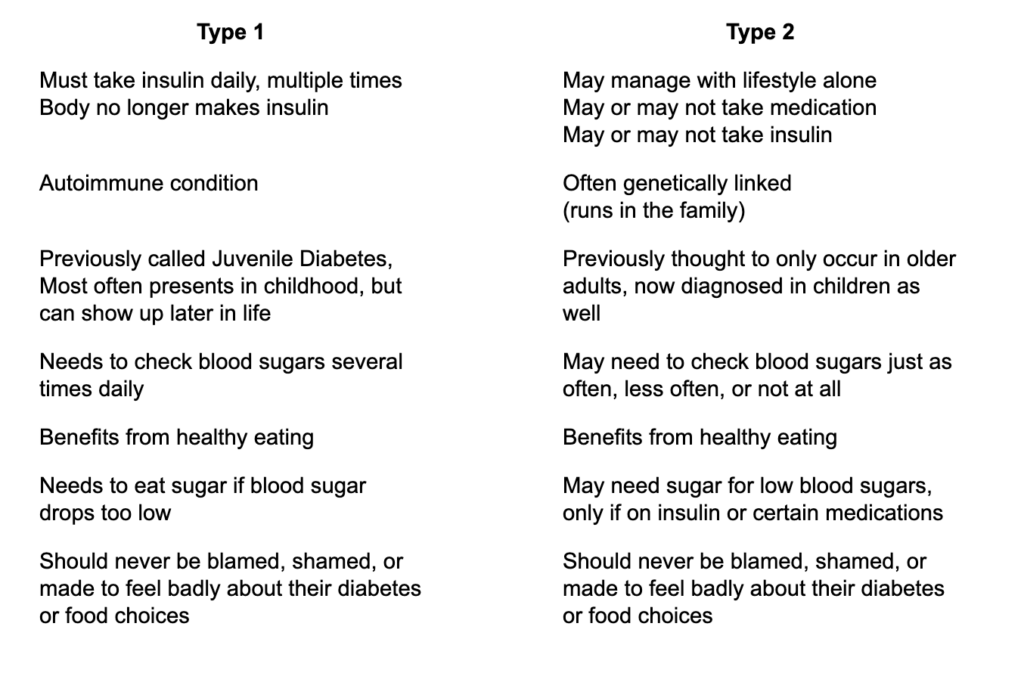Diabetes.
It’s not a big word, but it packs a whole lot with it. When I first meet a person or family who has received a diagnosis of diabetes, one of the first things I ask is: what comes to your mind when you hear “diabetes”?
The thoughts that pour out aren’t pretty.
No sugar. Carbs are bad. No fun foods. Can’t eat. What did I do to cause this….
We work through all that. We talk. We breathe. Sometimes we cry. They learn the truth of how to live a full, happy life with diabetes. Then they go on to do just that.
But later, once they have a good grasp on what diabetes means for their life (and doesn’t mean), the rest of the world still makes incorrect assumptions about diabetes. One of the frustrations I hear from clients living with diabetes is that people “just don’t get it”. These people could be classmates or colleagues, or close family members and friends.
Let’s get into it.
Diabetes. There are two types. Well, medically it’s actually a lot more complicated than that, and more types exist, but let’s keep this simple.
You have most likely heard mention of two types of diabetes: Type 1 and Type 2.
Most people assume that the numbers are a grading system, similar to stages of cancer, where a higher number indicates a worsened disease. This is not true for diabetes.
All the numbers really tell you, is that there is the type we knew about first, and the type we discovered second.
While both types of diabetes impact blood sugar levels, what goes on inside the body is different.
Type 1 diabetes has a simple, defining factor. A person with type 1 needs to take insulin, daily, to stay alive.
Where it gets complicated: some people with type 2 need to take insulin, too.
I know, I know, it can feel confusing.
I could say a whole lot of words here, but I’m going to summarize with a direct, side by side comparison. I know tables can seem boring or scary, but please humour me here…

At the end of all this, where do we end up? What understanding do we arrive at?
Here’s my dream: the type of diabetes someone has shouldn’t matter a whole lot when we are talking to them or about them. No one with diabetes, type 1 or 2, should ever be made to feel badly about their disease. People with diabetes are people. People who happen to live with diabetes. People who often have to put a whole lot of thought, effort, and hard work into something the rest of us take for granted: eating.
So, the next time you think “ohhh, Jenny has diabetes, and did you see her eating that cake? She shouldn’t be eating that cake”, I urge you to pause for a moment. Are you eating the cake? Are you enjoying the cake? Are you being judged for eating the cake?
People with diabetes can, and should, enjoy treats sometimes. Just like everyone else. Did you catch the sometimes in there?
This is how I explain it to 5 year olds, who look at me with fearful eyes and ask “can I still eat ice cream?” I take a deep breath, look fully into their brave eyes, and tell them: yes, you can still eat ice cream. But… Do you think you should eat a whole bucket of ice cream? For breakfast? (Cue adorable child’s smile.)
Not a single child gets this wrong. Not a single child, with or without diabetes, I will add.
It’s the same for all of us. So, let’s enjoy ice cream, sometimes, and fuel our bodies with nutritious foods the rest of the day.
Have someone in your life that you think would benefit from reading this? Please, share as you wish. Should that someone need a deeper dive into the details of diabetes, let’s say because they will be sharing your life or caring for your child, let’s chat. You both deserve to feel confident in their understanding of diabetes, so you can get on with the fun stuff.
— J.



